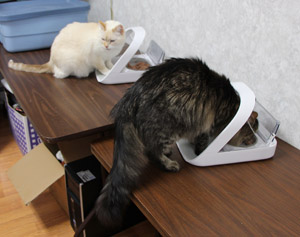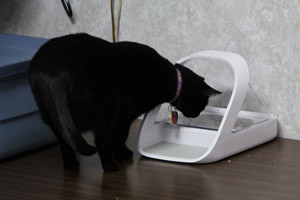2_cats_feeder_Oursler

Rocky and Marchives learned the new system quickly and were munching away in no time. Henny Penny (not pictured) had a longer learning curve. Photo by Dr. Teri Ann Oursler
I knew that if I lived long enough, I would eventually be faced with the cat clowder cuisine conundrum that several of my clients and their cat clowders lived through. What conundrum, you ask? The conundrum of having more than one cat on a medical diet that their housemate should not eat.
Let me introduce my clowder: Marchives, Kilolo (aka Henny Penny), and Rocky.
Marchives is a long-haired cat who has lived at the clinic for 10 years since he was found as a kitten. I brought him home from my clinic when I retired from practice. At that time, all of my cats at home were eating canned food, which is really best for most cat’s health, while my clinic cats were eating dry food. They were on dry food because Marchives had a long history of vomiting and diarrhea, and canned food made these symptoms worse. No medications ever worked for him and believe, me, I tried. While Rocky and Kilolo were healthier when eating canned food, I could not live with Marchives’ tail feathers dragging diarrhea all over. So I shifted them to Brand Y dry food and watched Rocky and Kilolo get fat and Marchives have diarrhea only every week or so. A balance was struck.
And then Marchives’ diarrhea got worse, until it was daily. And the messes were daily.
Let’s say that a combination of a cat with long tail feathers and diarrhea is not particularly pleasant. A colleague asked me if I had ever tried Brand X. Having nothing to lose at this point, I ordered a bag and started feeding my cats. Well, lo and behold, after a lifetime of diarrhea, Marchives was no longer producing the foul smelling stuff! Rocky and Kilolo were doing fine on it as well. For the first month. Until I ordered the second bag of the expensive stuff.
Kilolo is a slightly overweight Siamese cross cat who loved the new food, loves any dry carbohydrate-loaded food. However, I noticed that she was now hanging out at the water dish. Pacing in front of it obsessively. Oh great, just what I needed, a diabetic cat. NOT.
And so the conundrum was born: the Brand X dry food made Marchives no longer vomit or have diarrhea, but was starting to induce diabetes in Kilolo. And the best treatment for a diabetic cat? Canned food. Which gives Marchives diarrhea. See the problem here?
As many of my clients have had to do over the years, I had to find a solution to feeding my cats different diets for their medical conditions and prevent them from sharing their medical diets.
For two weeks I tried feeding the cats together, with me there to referee who was eating out of what dish. Sadly, I have to report that my attention span during these meals was poor. It did not take long for the cats to notice when I was not paying adequate attention, and they would switch dishes. I then tried to feed Marchives in the bathroom during meals, but he would not eat alone; he wanted to be part of the group. As far as he was concerned, I was punishing him by locking him up for a meal. So he didn't eat. That is not good in a cat that is already on the thin side. So off to find some other solutions.
I finally decided to try a new product that uses the cat's microchip. The door on the dish would open when my cat’s microchip was sensed. All I had to do was train the cats which feeder was theirs and get them used to the noise and movement of the lid opening to reveal the food. I plunked my money down and ordered two of these devices (one for Marchives, and one for Kilolo and Rocky to share). I also had to take Kilolo to the clinic for a microchip. Thankfully, Marchives and Rocky already had theirs.
I could not wait for my new toys to arrive. I got ready to use them: I had no batteries the correct size, of course. Several days later, having finally gotten batteries and read the manual on how to train the beasts, I was ready to start.
First and foremost, let me point out that the manual explicitly states, several times, that it takes patience to get the cats used to the movement of the lid. And let me point out that patience is not really my long suit (remember the inadequate attention during mealtimes?). The first three days went well, having the lid moving only about ½ inch when the cats put their head in and moving back that ½ inch when they pulled their heads out.
cat_autofeeder_Oursler

And then Henny Penny (aka Kilolo) all of a sudden noticed the movement. Why now, after three days of not caring about the movement? Who knows, she is a cat! So she jerked her head back and said “There – did you see that? Did you see THAT? It moved! Really, it moved!” And since she stepped back, the feeder moved, imitating closing the lid, and she got flustered all over again. She calmed down a bit and stuck her head back in and caused it to move. Again, she jerked back, pointing out the moving lid, which caused it to move (again!), which flustered her little Henny Penny self. At this point, she was done. Hungry, knowing that the sky was surely falling, she swatted Rocky and left.
Meanwhile Marchives and Rocky were on training Step two of four with no problem. Head in, lid moves, munch, munch, munch, no problem. Head out, lid moves back to a partially closed position, all is right in their world.
After three days of training, I was back to square one, training them to eat out of the dish with no lid movement. In addition, I now had to feed Henny Penny separately because she blamed the boys for her moving dish problems and was swatting them every time they came near her and the new dish.
Now ― 12 days later ― I want you to know that Henny Penny finally, this morning, went to eat out of the feeder with full movement of the lid. It opened, she ate, it closed. The sky did not fall and all was right in Henny Penny’s world as long as the boys are not around while she eats!
What options are available to us when we find ourselves in the cat clowder cuisine conundrum? It varies a lot, from clowder to clowder, cat to cat, and family to family.
By nature, cats are grazers, they prefer to eat several small meals a day. And my cats really like to eat at 2 a.m., when I REALLY prefer to sleep. I was looking for a solution that allowed them that natural behavior, so I either needed to employ some tech or lose some sleep. (The latter was not really an option.) In addition, while Marchives and Kilolo both wear a collar and tags, I knew that Rocky could not wear a collar – we had been down that road and he either catches them on his teeth or loses them.
Some other options on the table include:
- Feeding in separate rooms. With some patience and closed doors, this has worked well for my colleague. She had enough space and more patience than I do.
- If you are trying to get one cat to lose weight, putting the food some place where the fat cat cannot get will work. If he can’t jump, put the food up high. Put the skinny cat’s food in a place that can only be accessed by the skinny cat (partially blocked door) or a small cat door into a separate room.
- Create a feeding box or crate with a cat door that is activated by a tag on a collar. There are several electric pet doors on the market.
- Feed each cat in their own crate. But if you are like me (remember that inadequate attention span?), set a timer to remind yourself to let them back out.
Each household is different in its needs and it may take some patience, especially if you have a Henny Penny cat, but you too can solve the cat clowder cuisine conundrum.
I sure hope Henny Penny does not regress…